PinotFile: 10.26 February 26, 2016
|
Big Basin Vineyards: Whole Cluster Goodness Pinot NoirThe Santa Cruz Mountains is the birthplace of Pinot Noir in North America, yet this enigmatic winegrowing region remains under appreciated by many Pinot Noir cognoscenti. Matt Kramer has called it “California’s alltime most underrated wine district.” One of the reasons is evident when driving through the hilly landscape in search for wineries to visit. Unlike every other major winegrowing region in California, wineries and vineyards are not visible from the major thoroughfares and are tucked into nooks and crannies among heavily forested woods or perched on hilltops accessible only by lengthy and precariously narrow and zigzagged roads. Wineries are scattered among 480,000 acres of the appellation, signage directing visitors to wineries is nonexistent and GPS assistance is lacking in many areas.
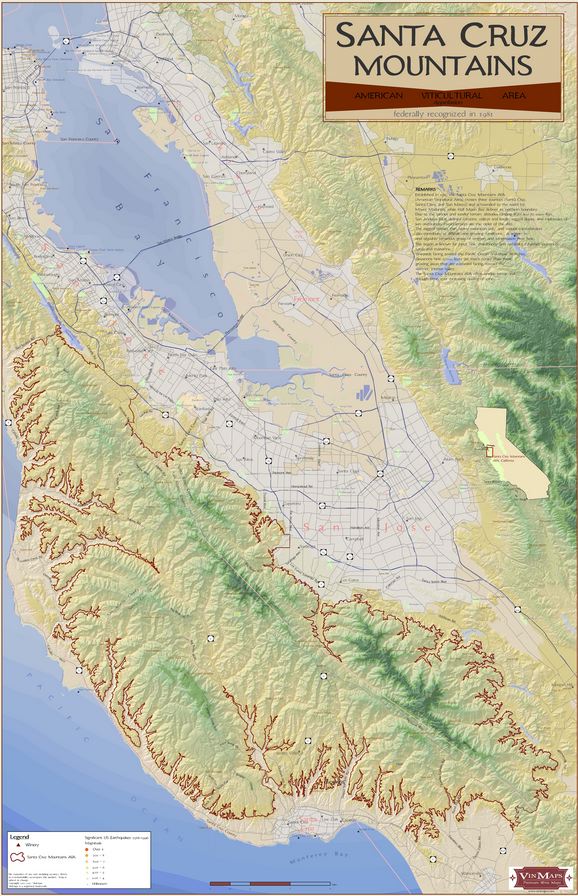 The challenges of growing wine grapes in the mountainous terrain with its harsh climate are numerous. The vineyard sites are remote, steep and rugged, land is expensive, irrigation water is limited, and pests such as birds, deer and gophers are ever present. Skilled labor is hard to find, top soil is poor and limited in many sites, and yields are typically low. On top of this, the antagonistic and bureaucratic populace make life difficult for wineries. Despite these obstacles, a hardy brotherhood of dedicated and passionate vintners empowered with mountain spirit have persisted. One winery among the 62 members of the Santa Cruz Mountains Winegrowers Association (SCMWA) that stands out is Big Basin Vineyards. Iconic wineries of the Santa Cruz Mountains such as Mount Eden Vineyards, Rhys Vineyards, Thomas Fogarty Winery and Windy Oaks Estate Vineyards and Winery have built their much-deserved reputation, but Big Basin Vineyards has ascended over the past 18 years to join this upper echelon of mountain Pinot Noir royalty.
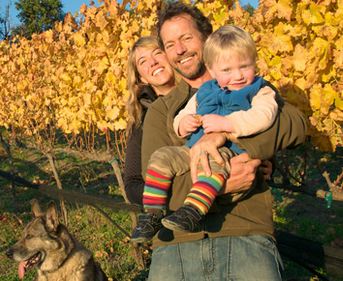 Founded by winemaker and winegrower Bradley Brown, his sister Wendy Brown and Samantha Shakti-Brown in 1998, Big Basin Vineyards is located on a historic site in Boulder Creek next to Big Basin Redwoods State Park in the western reaches of the Santa Cruz Mountains AVA. French immigrants had begun to farm wine grapes here 100 years ago and continued until 1965 when the property was sold to a timber company. The site now includes an organically certified Rattlesnake Rock Vineyard (planted in 2000 to Syrah and Grenache), Old Corral Block (planted in 2006 to Alban selection of Syrah), Homestead Block (planted in 2007 to Grenache, Syrah and Rousanne Alban field selections) and a winery (completed in 2003). On the second floor above the winery, a yogi studio, Shakti Yoga Shala, is Samantha’s domain. Over 90% of the estate property has been preserved in its natural state. I met Bradley on a number of occasions through the years and sampled a number of his well-crafted Pinot Noirs, but it was at the 2015 World of Pinot Noir event where he poured his 2012 vintage Pinot Noirs that I fully recognized his accomplished winemaking. Bradley grew up in a wine family, where his father was a home winemaker and his brother was a Francophile and wine lover. After moving to California after college, he became immersed in the wine business and developed his winemaking skills. Since the first vintage of Big Basin Vineyards wines in 2002, Bradley has grown his portfolio of wines to include five different single-vineyard Pinot Noirs along with a lineup of Rhone varietals. He has made it his mission to seek out the very best vineyard sites for Pinot Noir in the Santa Cruz Mountains and Monterey County, and in conjunction, has refined his winemaking, using more whole clusters in fermentation and less new oak barrel elevage. As readers know, I am partial to Pinot Noir made with whole cluster fermentation. Bradley is one of the cadre of California winemakers who uses significant whole cluster and whole berry inclusion in their ferments and this is largely responsible for my attraction to the wines. I asked Bradley how he chooses the percentage of whole cluster to include with each of his wines. He told me the following. “There are a number of factors that influence what percentage of whole cluster I might choose to use. Generally, with the vineyards I work with being very close to the ocean and cool, I see very good stem lignification. Therefore, we can use up to 100% whole cluster without introducing astringent and green tannins into the wines. Sometimes in their youth, the wines will show some stem-induced qualities, but these always age out after a year or two in bottle. In the 2013 vintage, I was still feeling out just how far I could go with some of the vineyards, so I did some ferments 100% whole cluster and some with less, with the resulting wines ending up with less than 100%. In 2014, virtually every Pinot Noir ferment was 100% whole cluster with awesome results. In 2015, I backed off on some vineyards due to excessive shatter (and hence less fruit and more stem). Other factors that might influence percentage of whole cluster are earwig prevalence and excessive shot berries.” Bradley finds whole cluster ferments engaging because “whole cluster changes the fermentation kinetics to slow things down and adds greater potential for intra-berry fermentation. The benefits are more beautiful aromatics and a layer of dense tannin that lends weight and structure to the wines.”
2014 Big Basin Vineyards Monterey County Pinot Noir 13.0% alc., 420 cases, $36. Release spring 2016. A combination of Coastview and Olson vineyards. Clones are 114, 115, 667, 777 and Swan selection. Harvest Brix 22º-23º. 15-year-old vines. 85% whole cluster, native yeast fermentation. Aged 11 months in French oak barrels, bottled unfined and unfiltered. · Moderately light reddish purple color in the glass. The nose is a little more savory than fruity, offering aromas of cherry, spice, pine sap and rose petal. The light to mid weight core of cherry and spice flavors is lifted by good tension and supported by matching tannins. A silky texture adds to the enjoyment. Over time in the glass, a stemmy note emerges on the nose and palate, but this should ameliorate with more time in bottle. Score: 88-89
2013 Big Basin Vineyards Coastview Vineyard Monterey County Pinot Noir 13.6% alc., 240 cases, $44. Released February 2016. This vineyard is located in the Gabilan Mountains with a commanding view of the Salinas Valley. Soils are nearly identical to Calera’s famous Mt. Harlan vineyards a few miles to the North. Owner John Allen farms the vineyard, planted in 1999, organically. 17-year-old vines planted at 2200 feet elevation in soils of decomposed quartz and granite over base rock with veins of limestone. Clones are 113, 114, 115, 667, 777 and Pisoni selection. 30% whole cluster, (first lot picked was 100% de-stemmed, the secon lot included 56% whole clusters, and the third picked lot 26% whole clusters), whole berry and native yeast fermentation. Aged 15 months in French oak barrels, bottled unfined and unfiltered. · Moderately dark reddish purple color in the glass. Clean aromas of black cherry, black raspberry and earthy flora hold up nicely over time in the glass. Lovely mid weight plus flavors of black cherry and black raspberry with a deft touch of oak in the background. Expansive in the mouth, with remarkable length and fruit intensity on the finish. The tannins are fine grain and easy going making the wine quite approachable, but the wine should pick up more nuance with additional time in bottle. Score: 90-91
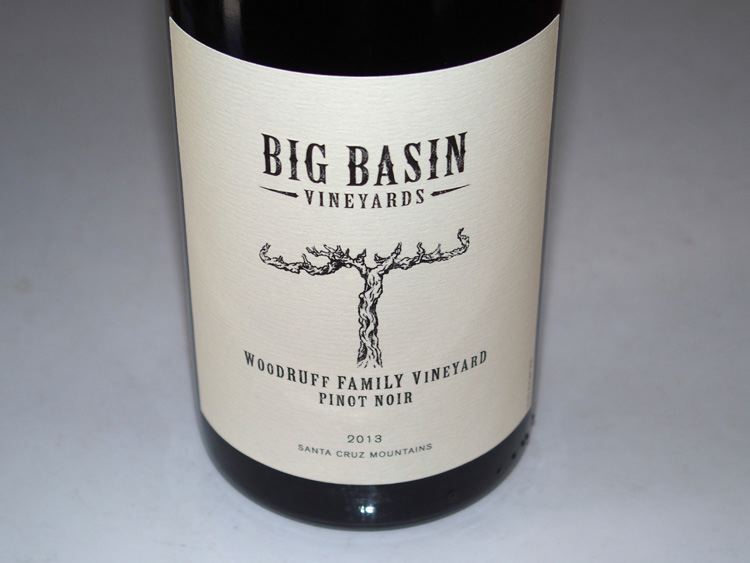 2013 Big Basin Vineyards Woodruff Family Vineyard Santa Cruz Mountains Pinot Noir 12.6% alc., 170 cases, $60. Release April 2016. 36-year-old vines (one of the oldest vineyards in Santa Cruz County) planted at 436-515 feet elevation in sandy loam over bedrock soils. 4 acres of Pinot Noir planted before the arrival of Dijon clones. Dry-farmed vines in Corralitos. Yield about 2 tons per acre. 75% whole cluster (one lot with 100% whole clusters and the other 42% whole clusters), whole berry and native yeast fermentation. Aged 15 months in French oak barrels, bottled unfined and unfiltered. · Moderate reddish purple color in the glass. Lovely perfume of red and blue berries, spice and rose petal. On entry, the wine is exotically spiced with a delicious complement of red berry and cherry fruit flavors embellished with salient but not overbearing whole cluster goodness. Plenty of nuance in this wine such as notes of savory herbs and sweet smoke, and more subtleties will emerge over time. Thoroughly enjoyable now, with modest but supportive tannins and an energetic finish. Score: 92-93
 2013 Big Basin Vineyards Lester Family Vineyard Santa Cruz Mountains Pinot Noir 12.8% alc., 240 cases, $48. Released September 2015. 15-year-old vines planted at 485-570 feet elevation in sandy clay loam over sedimentary base rock soil. This feature vineyard consists of 12 acres of Pinot Noir on Pleasant Valley Road in Corralitos. The vineyard is farmed by noted viticulturist Prudy Foxx: no herbicides, deficit watering and careful canopy management. Clones are Mt Eden (37), 115 and 667. 76% whole cluster (varying percentages from 100% to 57%), whole berry and native yeast fermentation. Aged 15 months in French oak barrels, bottled unfined and unfiltered. · Moderate reddish purple color in the glass. The nose is intoxicating with its blend of dark red cherry and berry, exotic spice, dark rose petal and pine sap aromas. Fans of whole cluster inclusion will go ga-ga over this wine with its array of luscious dark red and black cherry fruit flavors, plenty of spice, a hint of tobacco and savory tea, and a floral note in the background. The wine has impressive harmony with a welcome acid lift that brightens the experience. Add a dreamy texture and you have a compelling wine that is what the French like to call bien élevé. Score: 95-96
2013 Big Basin Vineyards Coast Grade Vineyard Santa Cruz Mountains Pinot Noir 13.2% alc., 135 cases, $48. Released November 2015. 5-year-old vines planted at 1240-1340 feet elevation in loam over limestone base rock soil (there is a limestone quarry across the street from the vineyard). Located in Bonny Doon about 3 miles from the Pacific Ocean. Clones are Pommard, “828,” and 667. Harvest Brix 23.4º-24º. 20% whole cluster, whole berry and native yeast fermentation. Aged 15 months in French oak barrels, 33% new, and bottled unfined and unfiltered. · Moderate reddish purple hue in the glass. Inviting aromas of crushed berries and black cherry with a complimentary note of baking spices. Smooth and satiny on the palate, with a middleweight charge of black cherry and black grape flavors. Open and embracing, and easy to like, with soft tannins, impeccable balance and some finishing goodness. I loved the seductive mouthfeel. Score: 92-93
2013 Big Basin Vineyards Alfaro Family Vineyard Santa Cruz Mountains Pinot Noir 12.4% alc., 175 cases, $55. Released November 2015. 14-year-old vines planted at 588-730 feet elevation in sandy gravel loam soil. Harvest Brix 22º. 40% whole cluster (one lot de-stemmed and one lot had 66% whole clusters), whole berry and native yeast fermentation. Aged 15 months in French oak barrels. · Moderate reddish purple color in the glass. The nose elevates over time in the glass, offering a lovely perfume of cherry, cranberry, dried rose petal and dried herbs. A mix of red fruits fills the mouth on entry, showing good richness on the mid palate, and finishing with a sprightly mix of red berries, whole cluster spice and a hint of oak. The texture is very comforting, and a welcome savory thread plays in the background. Well-crafted, with matched tannins. Score: 91-92
2012 Big Basin Vineyards Lester Family Vineyard Santa Cruz Mountains Pinot Noir 13.5% alc., 220 cases, $48 (retail offer). 42% whole cluster, whole berry and native yeast fermentation. Aged 15 months in French oak barrels, bottled unfined and unfiltered. · Moderate reddish purple hue in the glass. I loved the intoxicating nose with its hi-tone scents of crushed black cherries, bark, exotic spices, rose petal and pine sap. Seamless and sleek on the palate, with a mid weight array of vivacious dark red and black cherry and berry fruits complimented with a riff of spice, oak, anise and sassafras. The cohesive tannins and acidity are beautifully enmeshed with the fruit, and the peacock finish is eye opening. Score: 94
Bradley is on the Board of Directors of the SCMWA and is a member of the 32 select wineries chosen to represent Pursuit of Balance. The Big Basin estate and winery in Boulder Creek is open Passport Days sponsored by SCMWA and by special arrangement (refer to website for details). A Saratoga Tasting Room is located at 14598 Big Basin Way in Saratoga (not open to Passports on Passport Days) and is open to walk-ins Thursday-Monday. A majority of the wine is sold through a mailing list and three different wine club levels that offer club exclusives, priority allocations, special pricing, discounted or included shipping and special pricing or complimentary tickets to events. The winery’s informative and picturesque website is www.bigbasinvineyards.com. Big Basin Vineyards is a member winery of the Saratoga Wine Trail and a visit to Big Basin can easily be combined with a visit to nearby historic wineries such as Cinnabar Winery, Ridge Vineyards, Savannah Chanelle Vineyards and The Mountain Winery. Visit www.saratogawinetrail.com.
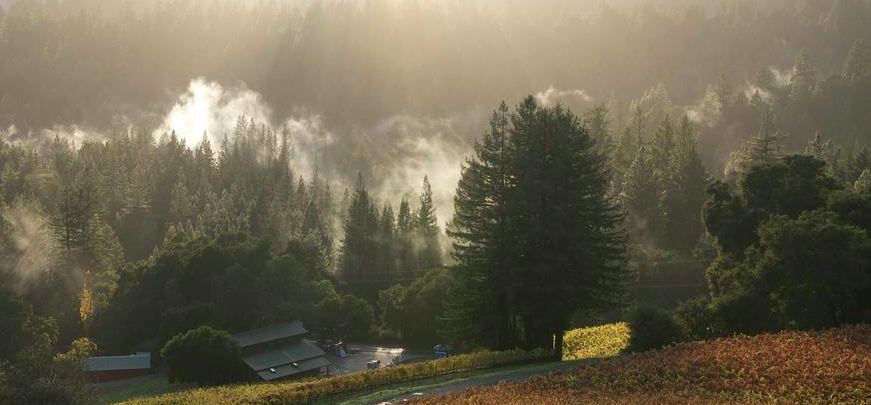 Marketing the Santa Cruz Mountains region has never been a strong suite of the winegrowing bureaucracy. For years, the Santa Cruz Mountains Winegrowers Association (SCMWA) held an annual 2-day Pinot Paradise event that was enthusiastically received by locals, but not a significant draw to those outside the region. In addition, the membership of SCMWA did not include all the region’s wineries, some of which were very prominent, and they did not participate in Pinot Paradise for various reasons. Pinot Paradise has been replaced by the Silicon Valley Wine Auction, a more glamorous affair held at Levi’s® Stadium Levi’s 501 Club. This event, to be held this year on April 16, includes a Saturday grand tasting featuring about 35 participating Santa Cruz Mountains wineries, a magnum and rare bottle silent auction, and a wine pairing dinner featuring unique wines from notable vintners of the Santa Cruz Mountains. This is the only opportunity to taste Santa Cruz Mountains Pinot Noir from multiple vintners at one venue. For further details and tickets, visit www.scmwa.com. Passport Celebration Days to the Santa Cruz Mountains has been offered four times a year since 1993. Members of SCMWA welcome consumers to 50+ wineries throughout the Santa Cruz Mountains on the third Saturday of January, April, July and November. Access to many wineries that are not normally open to the public is included.
Hibou Pinot Noir: Extraordinary DiscoveryOccasionally an amazing wine shows up at my wine locker without fanfare and unadorned by promotional material. I received an email in January from winemaker Jason Driscoll asking me to taste a Pinot Noir brand he started in 2014 with a friend. The wine is named Hibou (“ee-boo”), which means owl in French, a name that is reflects the presence of beautiful owls in the North Coast which are “hidden gems” according to Jason, akin to the Riddle Vineyard, a hidden gem of a source for Pinot Noir wine grapes he uses to make his singular bottling. Riddle Vineyard is located on Stoetz Lane in Sebastopol and is farmed meticulously by owner Jim Riddle. Jason sources Pinot Noir clones 115 and Pommard from this vineyard which is cane pruned and low yielding ( 3 tons per acre in 2014, less than 2 tons per acre in 2015). The vineyard is situated a few miles inland from the coast so it benefits from warm daylight hours tempered by evening cooling breezes. Soils are Goldridge and Franciscan shale. Jason drew a map of the vineyard last year:
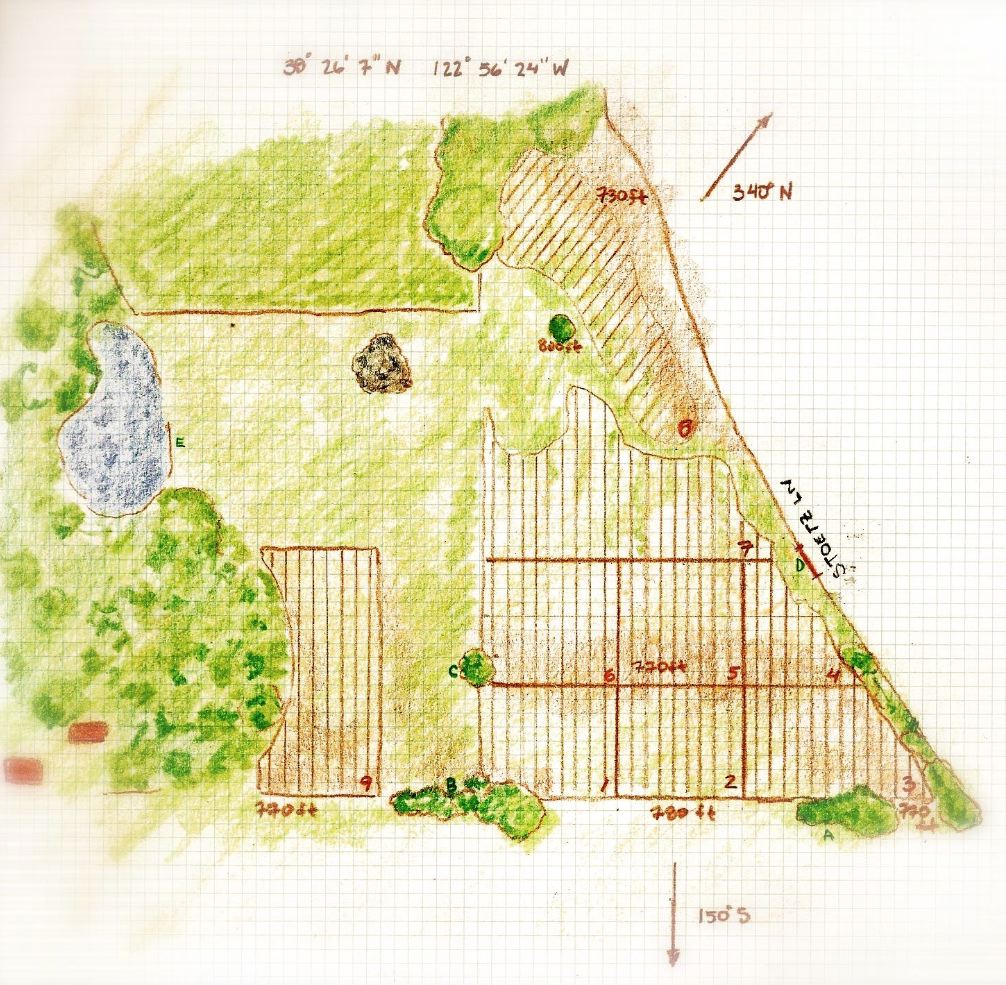 Jason’s background is interesting. He always planned to become a chef, and after graduating from Pepperdine University, he immediately applied to the Culinary Institute of America (CIA). Between graduation and enrollment in the CIA, he worked a harvest in Washington and cooked at a French restaurant on Pike Street named Campagne. When he moved to the Napa Valley to attend the CIA, he was offered the opportunity to work and stage at some special restaurants that enriched his knowledge of wine and food. After graduation from the CIA, he went to work as a cellar hand at Hunnicutt Winery, a custom crush facility in St. Helena. He told me, “I found the transformation of these clusters of grapes into something so complex more intriguing than creating a plate in a kitchen. I was quickly won over and fell in love with Pinot Noir fermentations.” Jason started collecting Pinot Noir wines and studying Pinot Noir producers. After leaving Hunnicutt, he worked at DeSante Wines as an assistant winemaker. While at DeSante Wines, he launched Hibou with Robert Quick, his friend from culinary school (who was foolish enough to help in funding the project as Jason says). Riddle Vineyard was the first contracted vineyard for Hibou, but the pair are looking for more sources to add to their winemaking program in the future. I was tasting the 2014 Hibou Riddle Vineyard Russian River Valley Pinot Noir one day with several other California Pinot Noirs. It was the last wine in the flight, and I was stunned to say the least when I tasted it. The wine clearly stood out among the others.
2014 Hibou Riddle Vineyard Russian River Valley Pinot Noir 14.2% alc., pH 3.68, TA 0.60, 144 cases, $58. Released October 1, 2015. Harvest Brix 24.8º. 50% 115 and 50% Pommard. The Pommard block was fermented with 100% whole clusters so the final blend is 50% whole cluster. Aged 10 months in French oak barrels, 50% new Remond. Unfined and unfiltered. · Moderate reddish purple color in the glass. Lovely perfume of fresh black cherries, spice, underbrush and a sweet floral intricacy. The perfectly ripened Bing cherry core is flat-out delicious, accented with a bit of spice, cola, dark chocolate and a trace of umami for good measure. Enviable composure and uncommon drink ability, with matched tannins and acidity, judicious use of oak, and a long, cherry-infused finish. This is one of a few exceptional Pinot Noirs that illicit emotion to the point that your excitement fuels a need to tell someone about it. I told my spouse who tasted the wine and absolutely loved it, and together we finished the wine quickly later in the day with dinner. Sublime. Score: 96
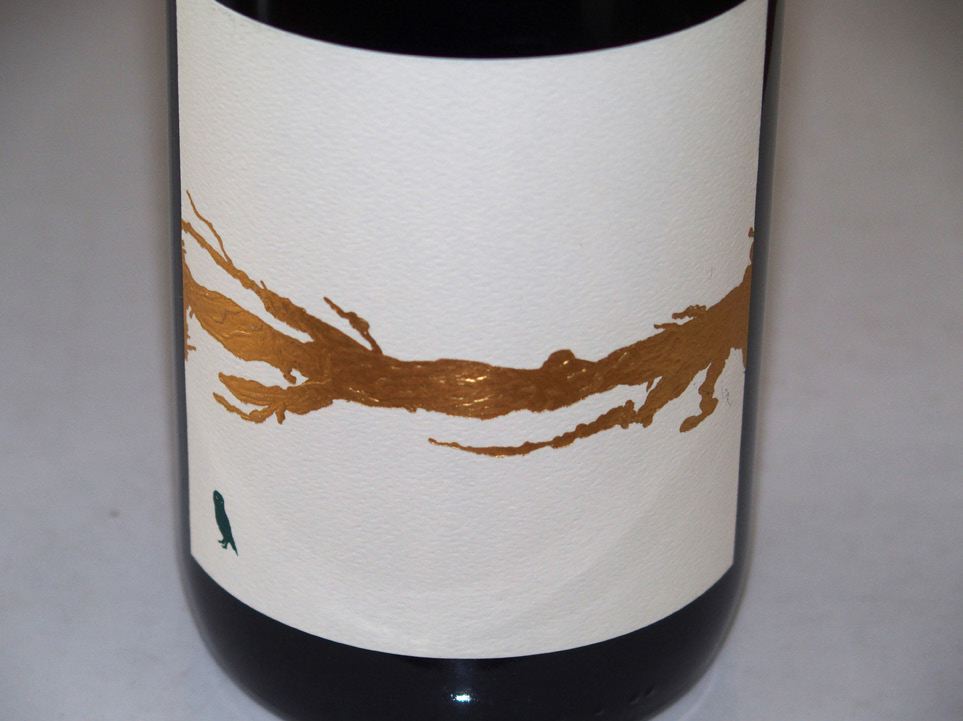
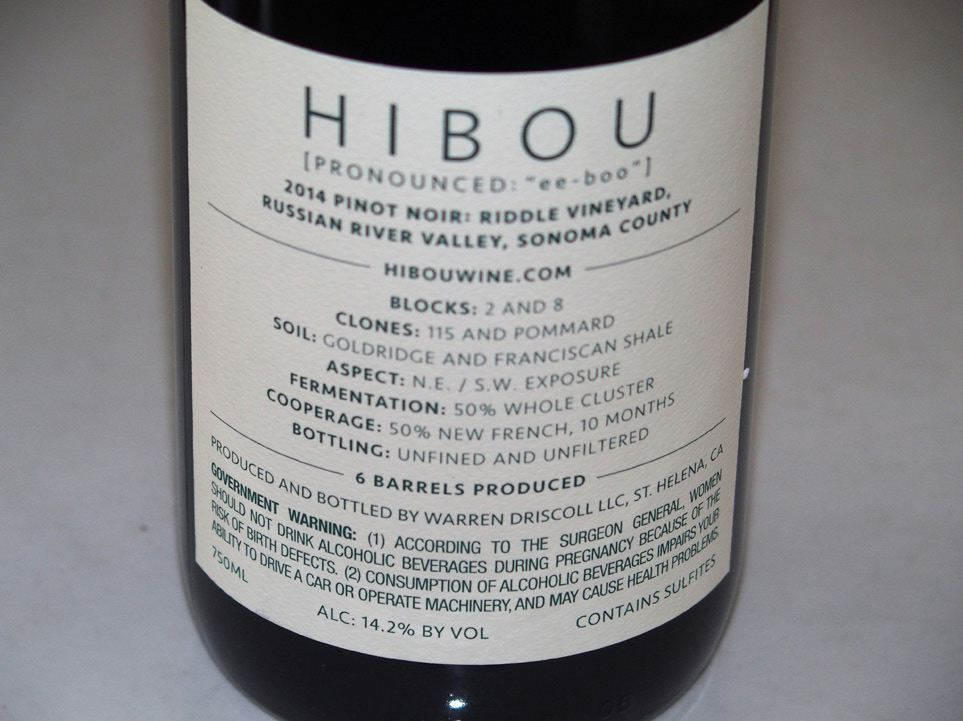
Visit the winery website at www.hibouwine.com to join the mailing list and buy your allocation of the wine. I understand your reluctance to throw $58 at an unknown wine, but in this case I think you will be happily rewarded.
Neighborhood Vineyards: Growing Pinot Noir in Urban San Francisco
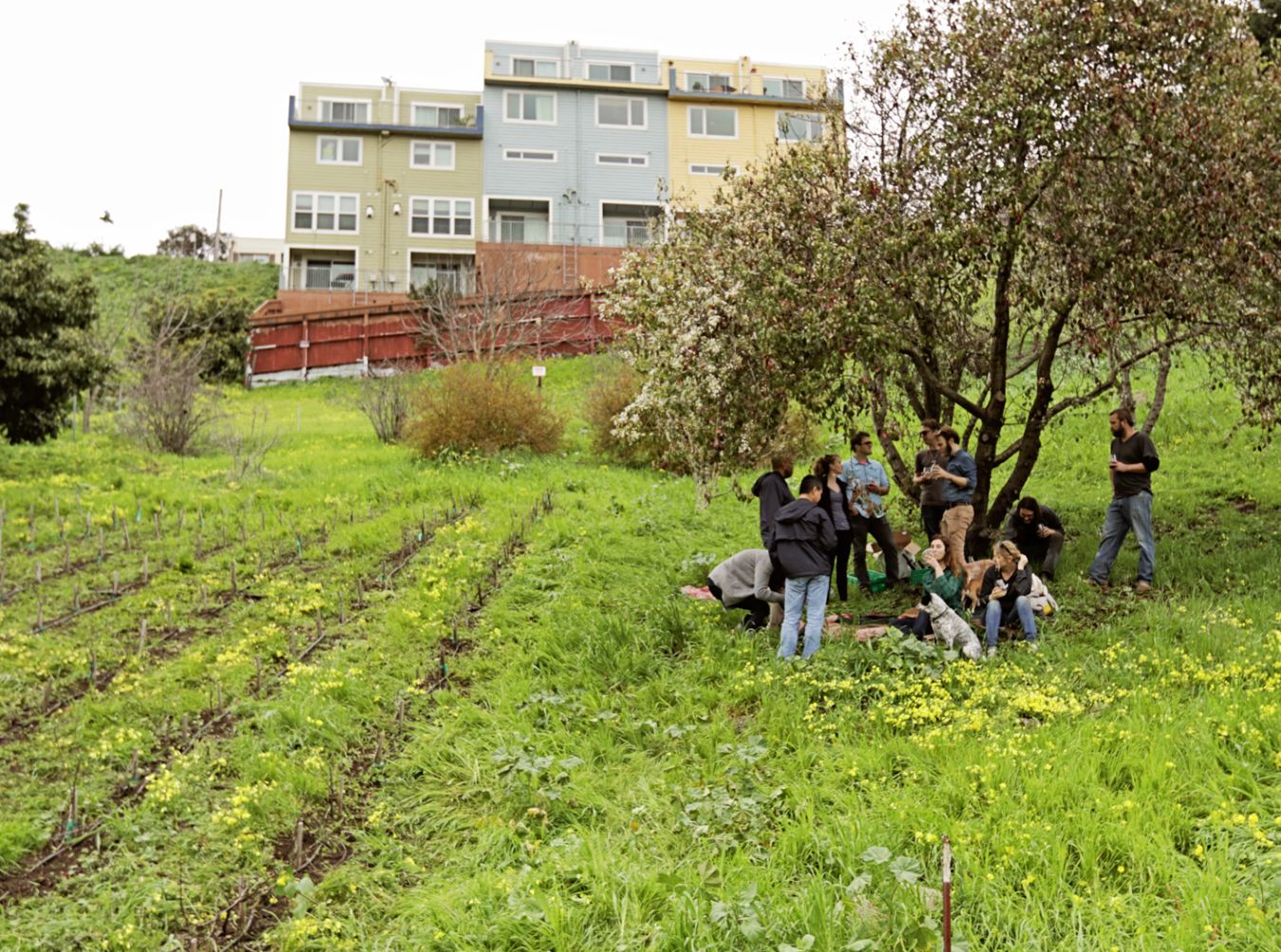
Neighborhood Vineyards is a novel urban community farm project started by Elly Hartshorn that began with the planting of a Pinot Noir vineyard in June 2013 at 700 Alemany Boulevard in downtown San Francisco. Although the website touts this as “America’s first urban vineyard,” I would think this is America’s first urban community vineyard, for I know of at least one other instance of an urban vineyard that preceded it. Stephen and Catherine Pepe, who later founded Clos Pepe Vineyard in the Sta. Rita Hills of Santa Barbara County, planted a private urban vineyard (Pinot Noir and Sauvignon Blanc) in Long Beach, California, and had their first harvest in 1991, the first in the history of Long Beach. I bring that up, not to diminish the accomplishments of Elly, but only to point out another example of an attempt to establish a domestic vineyard in an urban environment. Elly grew until age 10 years on her family’s 50-acre vineyard planted to Cabernet Sauvignon and Sauvignon Blanc in Lake County, California. She watched the Fetzers, Mondavis and Jess Jackson walk the vineyard with her father. Later, she attended Cal Poly at San Luis Obispo where her initial aspirations to be a mechanical engineer were superseded by a viticulture and enology minor and a job at Laetitia Vineyard & Winery out of college. Laetitia sells the majority of the fruit they farm and she was introduced to a host of young winemakers who were buying fruit. One of them was Russell From of Herman Story Winery. He asked her if she could help him write a newsletter for his mailing list customers, and Elly agreed if he would let her write the piece with uncensored humor rather than a polite and refined piece that Laetitia might publish. The newsletter became viral and she soon had a graphic design and marketing firm on her hands called Proof Wine Marketing. Along with business partner Josh McFadden, they created Sans Liege, Folkway and Field Recordings winery names, ideas, and labels as well as a handful of labels for Trader Joe’s wines. Other clients included Native9, Alta Maria, Tantara and J. Wilkes. Elly sold her shares in Proof Wine Marketing in 2009 and moved to France. Her design and marketing skills are on full display on the Neighborhood Vineyards website. Elly was living in France in 2010 and while employed at small vineyards and creameries, she discovered the hidden urban vineyard of Clos Montmartre. The Montmartre area had been one of several church-owned vineyards in Paris during the 18th and 19th Centuries, but increasing urbanization led to their disappearance. In the early 1930s, a group of local artists obtained a grant from the government to renew Clos Montmartre. The first harvest was 1934, and the grape-picking ceremony at this urban vineyard has been repeated every year since, except during World II. Clos Montmarte is the last active vineyard inside Paris and contains 1,900 vines and 28 grape varieties including Pinot Noir. Upon returning to California in the spring of 2012, Elly was actively planning to develop a project in San Francisco similar to Clos Montmartre. She gathered a team of viticulturists, winemakers and community friends to establish a 0.5-acre vineyard planted to Pinot Noir clone “828,” called “Alemany Farms,” in the Bernal Heights area. 230 vines were planted on rootstock 110r initially and there are now 349 Pinot Noir vines. The first harvest will be 2016. Since I have researched and written extensively about clone “828” (a suitcase selection brought from Burgundy to Oregon by Gary Andrus - the actual USD certified Dijon clone 828 has only recently been released for sale through nurseries), so I was curious why she chose this Pinot Noir cultivar among all others to plant in San Francisco. Here is her entertaining story in her words. “When I was reading the journals of California’s early European settlers, they asked themselves the same questions that I did for variety and clonal selections in San Francisco. What wine region is this land similar to? What are consumers’ expectations? What can we build a reputation for? (see relevant pages below published in 1880 and found by Elly at library during her research).”
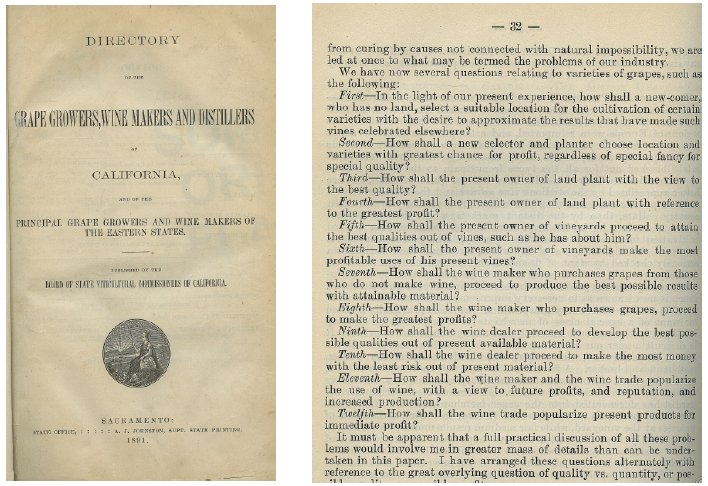 “I initially stayed away from Pinot Noir because I thought that wine drinkers had preconceived notions of what Pinot Noir should taste like and in San Francisco’s cold and potentially unripening climate, I might disappoint them when the fruit was more akin to Spätburgunder. I was instead leaning towards a German-Austrian hybrid like Zweigelt. I figured few people were familiar with the grape and we could set the bar for a flavor profile, and I could geek out with fellow wine people on an obscure grape. When I recounted this idea to two friends and colleagues who help me with the project, Andrew Jones of Sunridge Grapevine Nursery & Field Recordings Winery, and Lino Bozzano of Laetitia and Folkway Wine Company, I recall Lino saying, “Elly, you are planting the first urban vineyard in San Francisco which is now America’s most expensive city, you are farming it by hand without the use of machinery, without pesticides, and without a fence. Why the hell would you want to make your life any harder? Let’s plant Pinot Noir. We know something about it. “With the hype of being so difficult and fussy, some might laugh at Pinot Noir being the practical choice. Practicality aside, this vineyard project isn’t a trendy whim, but rather a serious endeavor. I want to make the best wine possible from the site, and I think Pinot Noir will grow well here. From a winemaking perspective, I will need other wine for topping off the San Francisco barrel and I have more access to Pinot Noir than Zeigelt at this point.” “Our next step was clonal selection. While the vineyard is on a slope and the soil has decent drainage, we were concerned with the soil retaining too much water and the threat of mildew. We hoped that 828’s vigor would offset the water retention. The clone is also more rot resistant than other clones and the droit (upright) growing attitude allows for better air flow to fight mildew pressures. So far, the vines seem to be establishing themselves rather well and mildew has been minimal.” Elly realized that the San Francisco vineyard would never yield a great deal of wine and she did not want the wine to become coveted and expensive. The whole point of the urban community vineyard project was that it would be approachable and educational, and not elitist. With this in mind, she produces a host of wines from other regions to get the project in the hands of many people. These wines range in price from $18 to $30. She works with old Central Coast winemaking friends such as Andrew Jones, Lino Bozzano, Jeff Fink and Christian Roguenant to produce these wines. Each wine is dedicated to tell a story about California viticulture. Neighborhood Vineyards wines are sold on the website at www.neighborhoodvineyards.org. Involvement in the vineyard project is encouraged. Vine sponsorships are available for $200. Subscribers can also participate in work days at the vineyard. The exact location of the vineyard is indicated below.
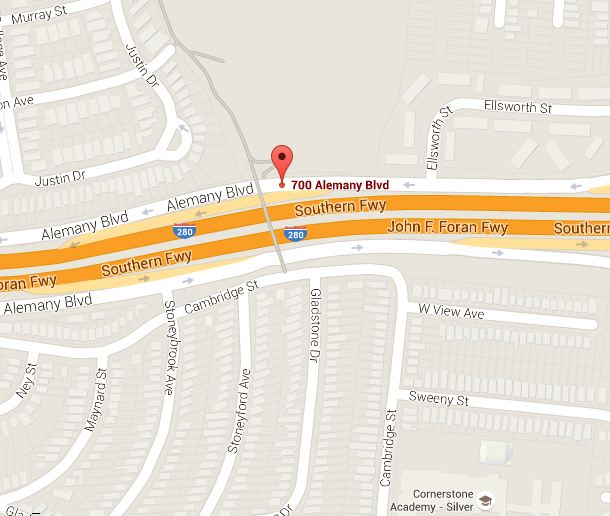 Elly also currently owns a wine storage and delivery business called Sidekick Delivery. The company serves the warehousing and delivery needs of small and mid-sized craft beer and wine projects in California. Visit www.sidekickdelivery.com.
Sips of Recently Tasted Wines
Aiken WinesJoel Aiken, who has over 30 years of winemaking experience in Napa Valley, including 27 years spent at the iconic Beaulieu Vineyard, started this personal project in 2009 to offer site-specific Cabernet Sauvignon and Pinot Noir from special vineyards of character. Joel had a remarkable career at Beaulieu Vineyard, rising to winemaker at the age of 28, and implementing many innovative winemaking techniques as well as conducting extensive Pinot Noir clonal research in the winery’s Carneros vineyards. For years, Joel worked side-by-side with the legendary André Tchelistcheff. Today, Joel produces wines for a number of clients including Amici Cellars, Rare Cat Wines and Chase Cellars, and along with his winemaker spouse, Amy, is proprietor of Palisades Wine Co. in Calistoga, where the couple make their wines. Visit www.aikenwines.com.
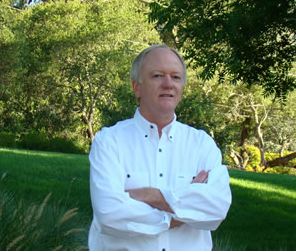
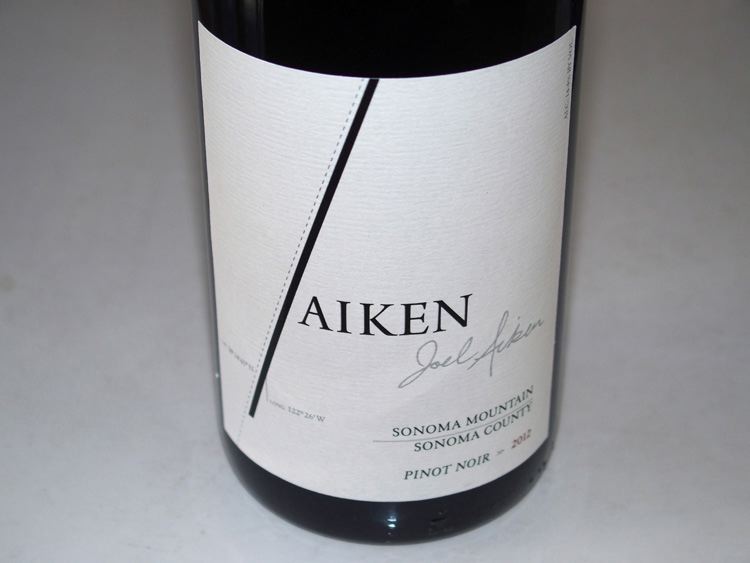 2012 Aiken Sonoma Mountain Pinot Noir 14.4% alc., 280 cases, $55. Sourced from Silver Pines Vineyard situated at 1000 feet elevation on Sonoma Mountain. A blend of clones 23 and Pommard. 100% destemmed, 4-day cold soak, aged in 33% new French oak barrels. · Moderate reddish purple color in the glass. Very enticing aromas of Bing cherry and spice cabinet holding up over time in the glass. Deep flavors of black cherry, black raspberry and blackberry dance on the palate, accented with floral intricacy and complimentary oak, finishing with purpose. The healthy mountain tannins are nicely concealed and the overall impression is one of great harmony. Score: 93
2013 Aiken Sonoma Mountain Pinot Noir 14.8% alc., 173 cases, $55. Sourced from Silver Pines Vineyard situated at 1000 feet elevation on Sonoma Mountain. A blend of clones 23 and Pommard. 100% de-stemmed, 4-day cold soak, aged in 33% new French oak barrels. · Moderate reddish purple color in the glass. Conservative aromas of black cherry, blackberry jam and toasty oak lead to plenty of ebullient black cherry and blackberry fruit flavors backed by matched fine-grain tannins and a waft of oak. More ripeness, sappiness, oak imprint and generosity on the finish compared to the 2012 vintage of this wine. Score: 92
2013 Aiken Fiddlestix Vineyard Sta. Rita Hills Pinot Noir 14.7% alc., 146 cases, $55. A blend of clones 777 and Pommard 5. 100% de-stemmed, 4-day cold soak, aged in 33% new French oak barrels. · Moderate reddish purple color in the glass. An array of dark red and black berry aromas infused with graphite and woodland scents greet the nose. The middleweight flavors of dark red and purple berries are framed by wellhoned tannins and judicious oak. Noticeably vigorous on the attack with a welcome intensity on the finish that offers gratifying length. Very similar to the Sonoma Mountain Pinot Noirs in style, but this wine has its own cachet. Still redeeming the following day when tasted from a previously opened and re-corked bottle. Score: 91
Cambria Estate Vineyard & WineryJulia’s Vineyard Pinot Noir has been renamed Benchbreak Pinot Noir to recognize the vineyard source of the wine that is situated at a dramatic spot where the bench drops toward the Santa Maria Valley floor. New labels have been designed to capture the old vines and fossilized seashells that are the true essence of the estate. Some of the vines here have endured since the 1970s, thriving in the cool, maritime influences that funnel in from the Pacific Ocean, and allowing for the longest growing season in California. Since 2009, all grapes from the Estate Vineyard have been certified sustainable by the CCSW program. The vineyard has also been SIP certified since 2011. I have found in the past that the Julia’s Vineyard bottling is consistently one of California’s best value-priced Pinot Noirs. Visit www.cambriawines.com.
2013 Cambria Benchbreak Santa Maria Valley Pinot Noir 13.5% alc., pH 3.54, TA 0.54, $25. From a vineyard situated at 400-800 feet elevation on a bench overlooking the Santa Maria Valley. Produced by sisters and proprietors Julie and Katie Jackson. Clones are Pommard 4, Wädenswil 2A, 23, 667, 115, 777 and “828.” Aged 8 months in French oak barrels, 27% new. · Moderately light cherry red color in the glass. Earthy dark cherry aroma with an overlay of seasoned oak. Polished and juicy in the mouth, with mid weight flavors of black cherry, black raspberry, black tea and anise with conspicuous, slightly drying oak in the background. A like able wine with a backbone of fine gritty tannins and a finish infused with modest but appealing cherry goodness. A solid, quite affordable, everyday Pinot Noir for the dinner table. Score: 89
Dunsten WinesDurell Vineyard owner Ellie Phipps Price launched Dunstan Wines in 2008 with fruit sourced exclusively from the 8.5-acre Ranch House Block located at the heart of the Durell Vineyard surrounding the original ranch house on the property. Durell Vineyard is located in the southwestern hills of Sonoma Valley, straddling the Carneros, Sonoma Valley and Sonoma Coast appellations. Visit www.DunstanWines.com.
2013 Dunsten Durrell Vineyard Sonoma Coast Pinot Noir 14.1% alc., pH 3.65, 425 cases, $55. From the 8.5-acre Ranch House Block of Durrell Vineyard planted in 2005. Calera, Swan, Dijon 667, 115 and “828.” Harvest Brix 23.5º. 100% de-stemmed, 7-day cold soak, extended 3 week fermentation. Aged 14 months on the lees in French oak barrels, 50% new. Winemaker Kenneth Juhasz. · Medium reddish purple color in the glass. The aromas emerge with swirling, revealing notes of dark red and black berries, earthy flora, and herbs including Italian sage and vanilla. The wine bursts with engaging strawberry flavor accented with a bit of cherry and seasoned with the slightest oak. Highly enjoyable, with modest tannins, balanced acidity, and a very charming burst of ripe strawberry and spice on the glorious finish. Score: 93
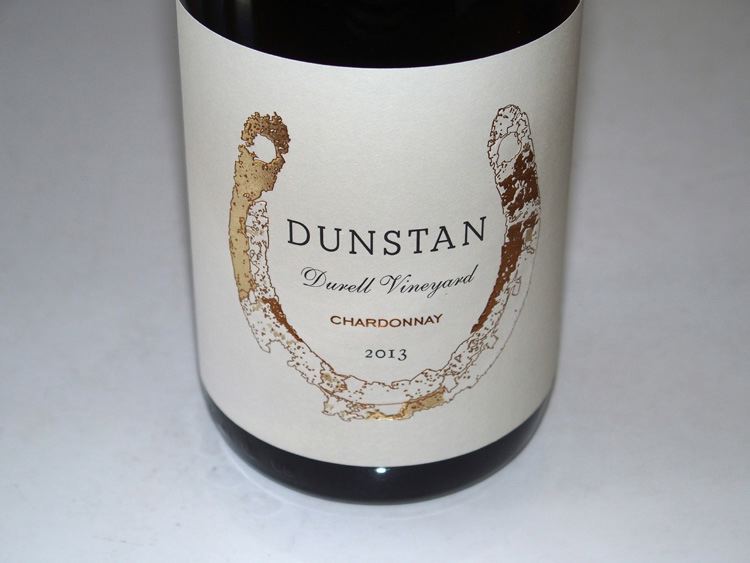 2013 Dunstan Durell Vineyard Sonoma Coast Chardonnay 13.7% alc., pH 3.65, 447 cases, $45. From the 8.5-acre Ranch House Block of Durell Vineyard planted in 2005 applying 25 years of farming experience at Durell Vineyard. Durell clone (Wente). Harvest Brix 22.8º. Whole cluster pressed to barrel and fermented with native yeasts. Aged 14 months in French oak barrels, 20% new. Winemaker Kenneth Juhasz. · Moderately light golden yellow color and clear in the glass. Subtle, but pleasing aromas of citrus blossom, apple and blonde caramel. A sophisticated and polished wine with an exquisite marriage of vivid citrus, apple and banana fruit flavors with oak accents, enlivened by crisp acidity. The wine’s beauty lies in the blend of bright acidity, a creamy texture and understated but engaging flavors. Score: 94
Engracia WinesOwner and winemaker Mike Faulk launched his brand in 2013 with these inaugural releases. The wines are a culmination of years of making wine in backyards, basements and garages. He left Florida in 2005 to further his winemaking goals, and now crafts his wines at a winery in Kenwood, CA. His inspiration is his grandmother, Engracia Perez Hernandez, a Cuban refugee who arrived in Florida in 1960. Grapes are sourced from longtime friend and grower Manuel Silva who owns Silva Vineyard. The winery’s website is www.engraciawines.com.
2013 Engracia Silva Vineyard Sonoma Coast Pinot Noir 12.1% alc., pH 3.46, TA 0.35, $35. Released May 1, 2015. After triple hand sorting, the grapes were whole berry fermented using proprietary yeast. Aged 18 months in a combination of 2-year-old and neutral French oak barrels. · Light cherry red color in the glass. Aromas of red berries, spiced dark chocolate, mulch, loam and clay lead to a light to mid weight wine featuring flavors of cherry, cranberry and a touch of oak. Forward, simple and elegant, with a silky texture and a modest finish. Tasted twice. Score: 88
2013 Engracia Silva Vineyard Sonoma Coast Chardonnay 13.1% alc., pH 3.49, TA 0.71, 128 cases, $30. Released May 1, 2015. Vineyard is located on the western side of Cotati. Grapes were picked in mid-October, about 3 to 4 weeks after most Chardonnay grapes in North Coast were picked. Whole cluster pressed, inoculated yeast ferment, 100% barrel fermented in neutral French oak. Malolactic fermentation was inhibited and less were stirred twice a week for 4 months. · Moderate golden yellow color and clear in the glass. Aromas of lemon and lime are complimented by a slightly chalky note. Flavors of citrus, poached pear, caramel and creme brûlée are supported by cleansing acidity. Nicely balanced, with a refreshing finish and some uncommon length (for a Chardonnay) on the pleasing finish. Score: 92
Maggy HawkMaggy Hawk needs little introduction as I have written extensively about this deep end Anderson Valley vineyard and the extraordinary wines produced by winegrower Dennis Winchester and winemaker Elizabeth Grant-Douglas. The Maggy Hawk label was launched with the 2007 vintage and five block wines featuring primarily a single clone are offered. Each wine is named after champion racehorses born to Maggy Hawk that proprietor Barbara Banke (Jackson Family Estates) celebrates in these wines. The wines are sold through at mailing list at www.MaggyHawk.com. I believe these are among the greatest Pinot Noirs currently being offered in California. In this vintage compared to 2012, the wines have less color, less extraction and tannin and better acidity. They are more “classic” and well-balanced styled Pinot Noir. These wines will turn out to be more age worthy than the more showy 2012 vintage wines. Hard to pick a favorite among the lineup.
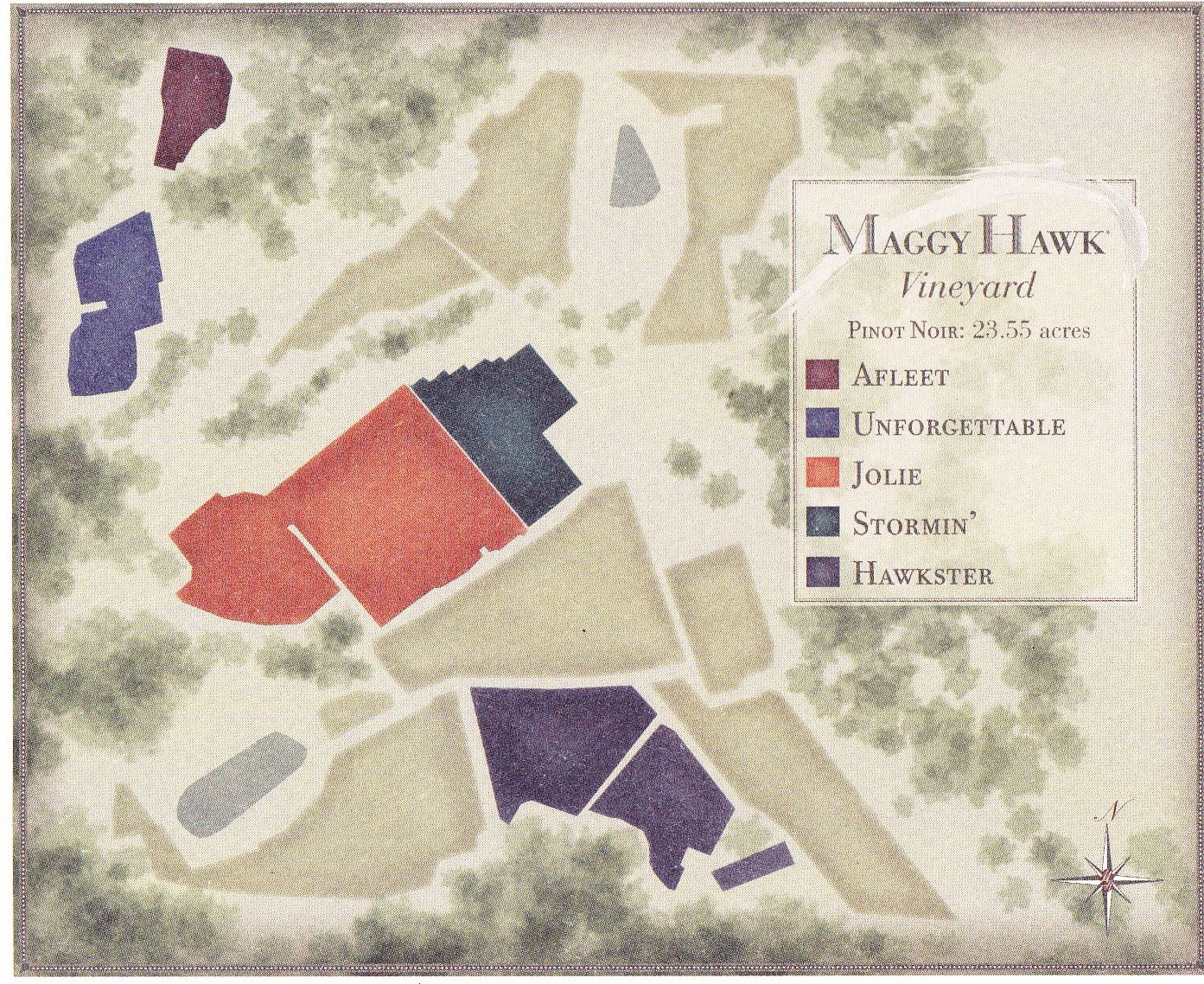
2013 Maggy Hawk Afleet Anderson Valley Pinot Noir 14.5% alc., pH 3.64, TA 0.58, 192 cases, $66. Primary clone is Pommard. 5-day cold soak, proprietary yeast primary fermentation, punch downs daily, aged 15 months in French oak barrels, 41% new. · Moderately light reddish purple color in the glass. A gorgeous perfume of black cherry, rose petal and vanilla arrives with more aromatic depth over time in the glass. The incredibly intense attack of black cherry, blueberry and pomegranate flavors bring the palate to attention. The engaging fruit envelopes the mid palate with purpose and is framed by filigree tannins. A special wine that although delicate in color, delivers sublime and boisterous flavors that are remarkably persistent on the energetic finish. The flavor profile is quite different from Pommard grown in the Russian River Valley. Score: 93
2013 Maggy Hawk Hawkster Anderson Valley Pinot Noir 14.5% alc., pH 3.73, TA 0.53, 268 cases, $66. Primary clone is Wädenswil 2A. 5-day cold soak, proprietary yeast primary fermentation, fermented in three separate lots unlike the other Maggy Hawk wines. Aged 15 months in French oak barrels, 49% new. · Moderately light reddish purple color in the glass. A panoply of dark red berries, earthy flora and wood spice greet the nose. In the mouth, the delicious flavors of dark red cherry, raspberry and spice are accented with a judicious touch of oak. The satiny texture is sensual and comforting and the wine’s balance is impeccable. Like all great wines, the intensely flavorful finish refuses to dissipate. Still exceptional the following day from a previously opened and re-corked bottle. Score: 94
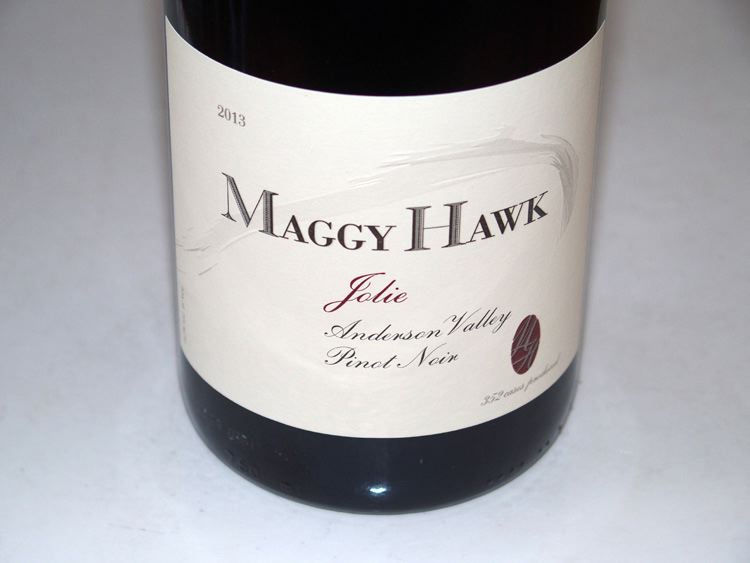 2013 Maggy Hawk Jolie Anderson Valley Pinot Noir 14.5% alc., pH 3.68, TA 0.52, 352 cases, $66. Primary clone is 115. Harvested multiple times over a 10-day period from October 8 to October 18 allowing the wine to display the full range of characteristics of clone 115. 5-day cold soak, proprietary yeast fermentation, punch downs daily, and aged 15 months in French oak barrels, 33% new. · Moderate reddish purple color in the glass. The markedly nuanced nose is a chameleon over time, taking on new aromas as it becomes more giving. Scents of dark berries, earthy flora, black cherry and spice are echoed on the palate. The fruit literally explodes on the mid palate, and holds on through a lengthy finish. Modest in weight, but highly flavorful, with tailored tannins, juicy acidity and a deft touch of oak. This wine tends to build in appeal over time in the glass. When tasted the following day from a previously opened and re-corked bottle, the wine was still terrific, indicating certain longevity. Jolie, will you marry me? Score: 95
2013 Maggy Hawk Stormin’ Anderson Valley Pinot Noir 14.5% alc., pH 3.76, TA 0.51, 236 cases, $66. Primary clone is 667. 5-day cold soak, proprietary yeast fermentation, punch downs daily, and aged 15 months in French oak barrels, 34% new. · Moderate reddish purple hue in the glass. The classy nose offers aromas of black cherry, spice, seasoned barrique and mushroom. A blast of cherry greats the palate in the primarily redfruited, mid weight wine. Not quite the fruit intensity of the other 2013 Maggy Hawk wines, but still impresses with great harmony, cashmere tannins, and a lip-smacking finish. The wine was still pumping out engaging aromas the following day from a previously opened and re-corked bottle. Score: 93
Nelson Hill WineryGreg and Barbara Hill farm a small, picturesque vineyard, the Deep End Vineyard, planted to Dijon clones 114, 115, 777, and Pommard. The vineyard is located just west of Highway 128 in Philo in the Anderson Valley. Deny Dudzik is the vineyard manager and winemaker who consults with winemaker Phil Baxter, Jr. Visit www.nelsonhillwinery.com.
2013 Nelson Hill Anderson Valley Pinot Noir 14.5% alc., 290 cases, $42. Released February 15, 2016.A majority of grapes are from the Deep End Vineyard at Nelson Hill with 13% Pommard from Ferrington Vineyard. · Moderately light reddish purple color in the glass. Shy, but pleasant aromas of black cherry and savory dried herbs. On the palate, the wine is pleasingly savory and fruity, with mid weight flavors of dark cherry, black raspberry, spice, herbs and a touch of toasty oak. Good harmony, with an array of dark fruits including blueberry, black cherry and pomegranate fanning out on the finish which leaves the slightest bit of warmth in its wake. Tasted twice. Score: 89
2012 Nelson Hill Deep End Vineyard Anderson Valley Pinot Noir 14.1% alc., 260 cases, $40. Released May 15, 2015. This rocky, south-facing vineyard is located on a slope only a few miles from the Mendocino coastline. · Moderate reddish purple color in the glass. A mid weight plus styled wine with a very ripe fruit profile. Aromas of crushed cherries, spice cake, sassafras and complimentary oak lead to satisfying and sappy flavors of black cherry, black raspberry, cola, spice and toasty oak. The tannins are submerged, the mouthfeel is plush and velvety, and the finish shows impressive length and welcome juiciness. Score: 90
Sonnet Wine CellarsSonnet is a small Santa Cruz Mountains producer of Pinot Noir founded by winemaker Tony Craig during his twelve-year tenure as winemaker for David Bruce Winery. A former Shakespearean actor originally from England, he was unable to find work as an actor after moving to California, and serendipity led him to answer a newspaper ad for a cellar worker at David Bruce Winery. He took to winemaking naturally, within 14 months was part of the winemaking team, and eventually became head of the vineyard-designate Pinot Noir program. He started the Sonnet Wine Cellars label in 2003, and now produces vineyard-designated Pinot Noir from Muns Vineyard in the Santa Cruz Mountains and Tondre’s Grapefield in the Santa Lucia Highlands. The 2013 Sonnet Wine Cellars Tondre’s Grapefield Pinot Noir won Red Sweepstakes and Best of Class awards at the 2016 San Francisco Chronicle Wine Competition. Tony also is the winemaker for Silver Mountain Vineyards, Muns Vineyard and Savannah-Chanelle in the Santa Cruz Mountains. Tony might be the only California Pinot Noir maker using 100% Hungarian oak barrels on all his Pinot Noir wines. He told me the following. “The Hungarian oak he uses is the same species as French oak. He prefers medium plus toast level achieved through a very low heat firing for almost an hour - otherwise too much caramel and sometimes licorice shows in the wine. He is able to get truly tight grain barrels from Hungary, whereas in France, the veneer industry tends to monopolize those oak trees. I find that Hungarian oak marries well with Pinot Noir and adds welcome baking spice.” Sonnet wines are sold through the former winery’s website with a link to www.silvermtn.com and through distribution to markets and retailers in the San Francisco Bay area. The Sonnet Wine Cellars website is minimalist and the wines are not sold directly at www.sonnetwinecellars.com, but don’t let that dissuade you from the excellence of the wines.
2013 Sonnet Tondre’s Grapefield Santa Lucia Highlands Pinot Noir 14.5% alc., $45. Harvest Brix 26.0º. 98% Pommard, 2% 948. Proprietary Assmanshausen yeast ferment. Aged 16 months in tight grain Hungarian oak barrels, 35% new, with lees stirring during malolactic fermentation. Unfined and unfiltered. · Moderately light reddish purple color in the glass. Clean aromas of purple grapes, dark cherries, and brown baking spices. Nicely composed, with a ripe fruited tone, featuring flavors of black cherry, blackberry and toasty oak in a middleweight style with good length. The gorgeous velvety mouthfeel says, “Drink me!” Score: 93
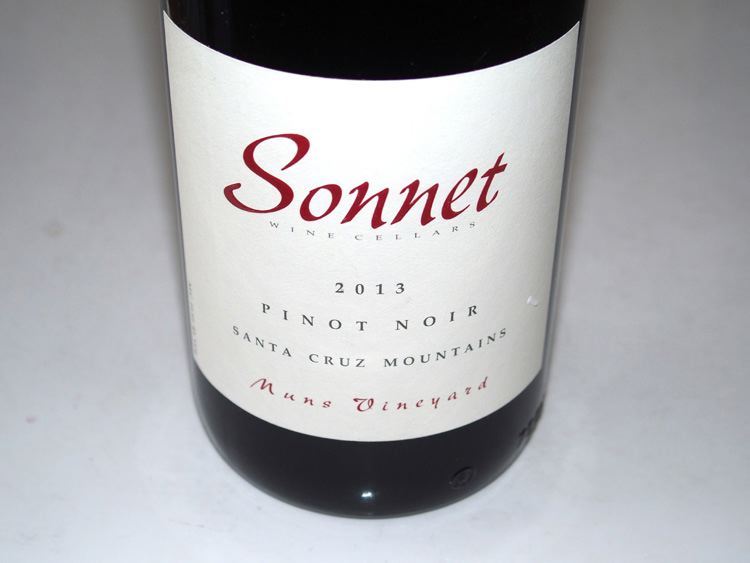 2013 Sonnet Muns Vineyard Santa Cruz Mountains Pinot Noir 14.5% alc., $38. Harvest Brix 26.0º. Clones 667, 777, 114 and 115. Proprietary Assmanshausen yeast ferment. Aged 18 months in tight grain Hungarian oak barrels, 35% new, with lees stirring during malolactic fermentation. Unfined and unfiltered. · Moderate reddish purple color in the glass. Engaging perfume of crushed cherries, spice, mulch and sandalwood. Delicious core of black Morello cherries soaked in Kirsch and raspberry fruit with a pinch of spice and vanilla. Beautifully balanced with suave tannins, a smooth mouthfeel, and a very long finish lingering for at least 30 seconds. When re-tasted later in the day from a previously opened and re-corked bottle, the wine was even more expressive, bursting with cherry and raspberry goodness. Pure Pinot class in the glass. Score: 95
More Wines
2014 Briceland Vineyards Humboldt County Pinot Noir 13.1% alc., 405 cases, $31. A blend of grapes from primarily Elk Prarie Vineyard, with contributions from Phelps, Alderpoint, Ronda’s and another vineyard near Benbow. · Moderate reddish purple color in the glass. Inviting aromas of crushed cherries, potpourri, and spice including Mexican oregano. A middleweight style with the flavor of boysenberry dominating on the palate and a mix of blueberry and pomegranate on the finish. Silky in the mouth, with harmonious tannins and an intensely fruited ending. Score: 89
2014 Lay of the Land Ben Morven Farm Marlborough New Zealand Pinot Noir 13.0% alc., $N/A (out of stock at time of review), screwcap. Imported by NakedWines.com, Napa, CA. The winemaker, Mike Paterson, was the head winemaker for ten years at a leading Marlborough Winery. Sourced from a non-irrigated, dry-farmed single vineyard. 20% whole cluster. Extra long 25 days on the skins. Aged in 100% French oak barrels, 10% new. · Moderately light reddish purple color in the glass. Both fruity and savory on the nose, with scents of cherry, strawberry, spice, woodland and earthy flora. Light to mid weight flavors of black cherry and raspberry are gently enhanced with oak. An easy drinking, forward style that becomes more savory over time in the glass, offering an earthy and herbal thread in the background. The wine finishes on a slightly tart and juicy cranberry note. Score: 89
2012 O’Connor Vineyard Russian River Valley Pinot Noir 14.2% alc., pH 3.38, TA 0.68, 371 cases, $33. From a family owned, 3.5-acre vineyard in Sebastopol. Custom crushed at Freeman Winery. Eric Buffington winemaker and Ed Kurtzman consulting winemaker. Harvest Brix 24.2º. Clones are Pommard, 115 and 777. · This is a commendable wine that is well crafted. Moderately dark reddish purple color in the glass. Classically Russian River Valley in character, with aromas and flavors of black cherry, cola, spice and a hint of dark chocolate and toasty oak. Nicely balanced, with silky tannins and some finishing length. Score: 90
2013 ROCO Wit’s End Vineyard Chehalem Mountains Oregon Pinot Noir 14.0% alc., 322 cases, $60, screwcap. Rollin Soles’ estate vineyard and winemaker. Dijon clones. · Light cherry red color in the glass. Aromas of cherry, cranberry and sous-bois lead to a deeply flavored light to mid weight wine with plenty of cherry flourish accented by a savory herbal thread in the background. Sleek and balanced, with a forward drinking attitude, but the wine should add weight and more appeal over time. Score: 90
2012 The Eyrie Vineyards Rolling Green Dundee Hills Oregon Pinot Noir 13.0% alc., $60. One of five estate vineyards. 6 acres at 540 to 720 feet elevation planted in Nekia clay loams overlying basalt cobble. Ungrafted Wädenswil and Pommard clones planted in 1989. · Moderate reddish purple color in the glass. Quite savory, with an earthy flora aroma dominating the nose. The mid weight core of spiced red and black cherry fruits offers an intense attack and notable presence on the mid palate. The honed, matched tannins make for easy drinking, and the juicy finish is uplifting. A bit more earthy, herbal and oak-infused than fruity at present. Score: 91
Pinot BriefsMillenials Drink Nearly Half of All Wine in United States There has been a marked increased in wine consumption by millennials, who drank 42% of all wine (159.6 million cases) in 2015 as reported by the Wine Market Council (WMC). Millennials include those between the ages of 21 and 38 and now make up the largest wine-consuming demographic in the United States (36% of all United States wine drinkers). Data indicates that millennials are trading up, with the WMC survey showing that older millennials were increasingly buying a bottle of wine costing over $20. I have two sons, who are both millennials and educated professionals, and they definitely consume wine, but also craft beer and exotic cocktails. However, neither one can afford to buy premium Pinot Noir that usually is priced above $50, and I wonder how this bodes for the future premium Pinot Noir market. The Baby Boomers, those aged 51 to 69 and Generation X, those aged 39 to 50, who make up the largest group of premium Pinot Noir consumers, have fallen to 36% and 34% of all United States wine drinkers. Consumers Still Prefer Chardonnay and Merlot The second annual report on American wine consumer preferences was released in November 2015 by Sonoma State’s Wine Business Institute. The study surveyed 1,072 wine consumers ages 21 to 68 (a relatively small sample in my mind). Even though sales of Pinot Noir have increased in recent years, when subjects were asked to pick their favorite grapes from a list, 50% included Chardonnay and 49% Merlot, 41% included White Zinfandel, 40% Pinot Grigio, and 38% Cabernet Sauvignon and Pinot Noir. Consumers reported that they preferred wines that were “fruity,” “semi sweet,” and “smooth.” Only 26% preferred dry wine styles. About 5% of respondents usually spend over $25 per bottle for wine that is drank at home. Moderate Alcohol Consumption Improves Lipid Profile The International Scientific Forum on Alcohol Research critiqued a published study, “Support for a causal role of alcohol consumption in improving the lipid profile,” found in PLos One 2016. The paper was based on data from more than 10,000 Americans of European descent who participated in the Atherosclerosis Risk in Communities (ARIC) study. The Forum concluded that the study provided important data indicating that light-to-moderate alcohol consumption has favorable effects on most lipid values. The effects shown for HDL-cholesterol support much earlier data, and the effects on small dense LDL-cholesterol and ApoB provide key new information. The effects of lipids are important factors in the protective effects of moderate drinking against cardiovascular disease that have been reported in almost all well-done cohort studies. To read the full critique, go to www.bu.edu/alcohol-forum/ critique-181. Wine Prevents Dementia Says Latest Study A review and analysis of almost 100 studies on the subject found that moderate wine consumption significantly delays dementia. Dr. Jeremy Spencer led the researchers who reported in the journal Safety, Consumer Preference, and Human Health. Phenols most commonly found in red and sparkling wine can help to protect brain cells from damage and keep nerve and brain cells communicating with other cells, thus countering the process that leads to Alzheimer’s Disease. 9th Annual Pebble Beach Food & Wine Festival Presented by Food & Wine, this 4-day event, March 31-April 3, 2016, attracts revered chefs from across the globe as well as acclaimed wineries for cooking demonstrations, wine tastings, and exclusive dining experiences set against the backdrop of Pebble Beach, California. The impressive list of California and Oregon winery participants who are primarily Pinot Noir producers includes: Antica Terra, Archery Summit, Belle Glos, Brooks, Chamisol, Domaine Anderson, DuMOL, Failla, Hahn Family, Hanzell, Keller Estate, MacPhail, MacRostie, Melville, Patz & Hall, Pisoni, Samsara, Testarossa, Three Sticks and Willamette Valley Vineyards. Tickets are available at www.PBFW.com. Sonoma in the City - Houston On Tuesday, March 1, a grand tasting of over 200 wines from 16 distinctive Sonoma County regions will be featured along with an array of appetizers, artisan cheeses and charcuterie. For tickets got to www.tastesonomahouston.eventbrite.com. Enter promotional code “friends” and get a 40% discount on your ticket. Jancis Robinson Launches Online Wine Course Renowned wine expert, Jancis Robinson, has developed a wine course which can give even complete beginners an understanding of wine in a single evening. The course includes 51 short lectures spread over 3.5 hours of video. Those that sign up for the course ($71) have lifetime access to its lectures and a 30-day money back guarantee. It is available on iOS and Android. Anyone beyond the initial stages of learning about wine will find this course interesting but less beneficial. Visit www.udemy.com/mastering-wine-jancis-robinsons-shortcuts-to-success/ for more details.
 8 Wineries have 60% of U.S. Wine Market According to Gomberg Fredrickson, Wine Institute based on data excerpted from Silicon Valley Bank 2016 State of The Industry Report, Gallo (21%), Wine Group (14%), Constellation (11%), Trinchero (4%), Bronco (3%), Treasury (3%), Delicato (3%) and Jackson Family (1%) have 60% of the U.S. wine market while 7,654 other wineries have 40% of the U.S. wine market.
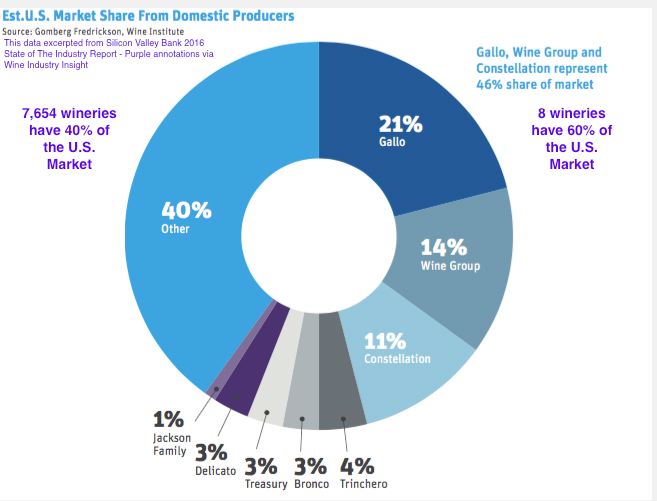 Report of Leading Grape Varieties Crushed in California in 2015 The USDA, National Agricultural Statistics Service, California Pacific Regional Office reported the percentage of each grape variety crushed out of the total 2015 California grape harvest. Thanks to Lewis Purdue of www.wineindustryinsight.com for this graph.
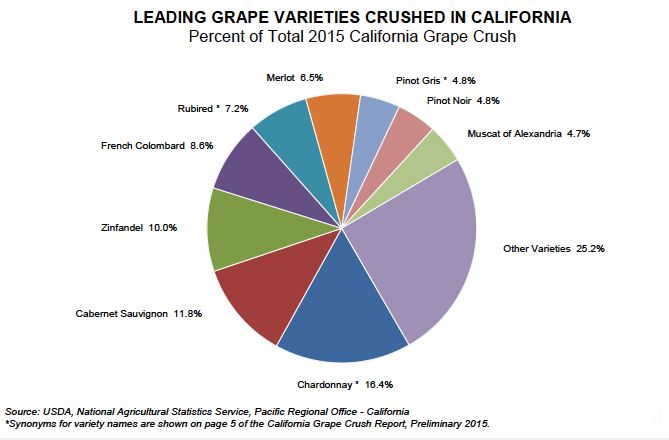 Sideways The Play to Debut in London. in 2016 According to www.decanter.com, a play of the Oscar-winning film Sideways will open at St. James Theater in London on May 26, 2016. The play will offer additional scenes not in the movie and other special features and twists, as well as dialogue from the novel that weren’t used in the film. (Photo credit: St. James Theater)
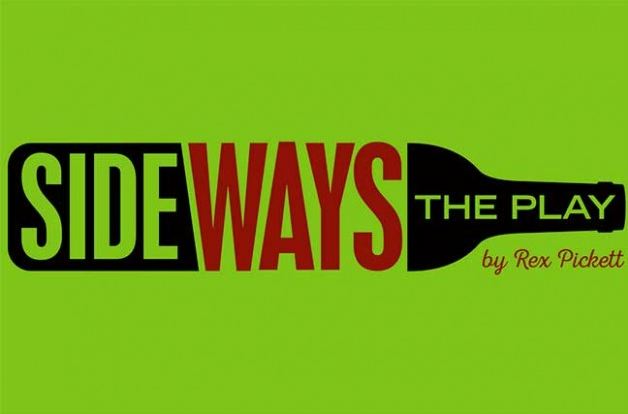 International Wine Film Festival Debuts This 3 week event series offers the best in wine-themed video from February 14 - March 5, 2016. This innovative experience was started by Wil Fernandez (the man behind the film, Vintage 2014) and is the first event of its kind. A number of wine and film events will be held in Santa Barbara County at vineyard locations, culminating in a screening of winning films at the Bacara Resort on March 5, hosted by Fred Dame MS. The screening in the Bacara Theater is open free to all WOPN early admission Saturday Grand Tasting ticket holders. Visit www.winefilmfestival.com and www.facebook.com/ WineFilmFestival. Linfield College in Oregon Launches Wine Studies Program Linfield College, located in McMinnville in the Willamette Valley of Oregon and the long time home of the International Pinot Noir Festival held each July, will begin offering students a wine studies minor to accompany their major degree of choice. Linfield’s faculty are involved in wine research projects, the campus houses the Oregon Wine History Project and wine archives, and the private college’s president, Dr. Thomas L. Hellie, is a wine enthusiast and advocate. Petaluma Gap Wineries River Cruise Four Petaluma Gap wineries will be on board for “Cruising The Rhone River” on the AmaCello, March 23-30, 2017. The wine hosts are Ana Keller of Keller Estate, Alexandre Remy of Agnitio Wines, Evan Pontoriero of Fogline Vineyards and Rickey Trombetta Stancliff and Erica Stancliff of Trombetta Family Wines. Experience four-course winemaker dinners, hosted tastings and seminars featuring more than 20 Petaluma Gap wines as you cruise through France’s Rhone River Valley. The 7-night cruise is $2,149 per person. For information, contact Expedia CruiseShipCenters, North Bay: wineclub@cruiseshipcenters.com and 877-651-7447. Russian River Valley Single Vineyard Night Small lot, single vineyard wines from the Russian River Valley will be poured Thursday, April 7, 2016, in Sacramento, CA, at Library Galleria. Sponsored by the Russian River Winegrowers, more than 20 wineries will be present including Balletto Vineyards & Winery, Davis Family Vineyards, Dutton-Goldfield Winery, J Vineyards & Winery, MacRostie Winery & Vineyards, Matrix Winery, Siduri, Sojourn Cellars and The Calling. Tickets: www.eventbrite.com. Vinotemp Zero-G Suspended Cable Wine Racking System This is a new and modern storage solution for your wine collection that caught my eye. When installed in a cabinet, the racking creates the illusion that your bottles are floating due to the configuration of wood blocks and aluminum rods. Racking and finish can be customized to accommodate your largest Pinot Noir bottles. Check it out at www.vinotemp.com.

Straight Talk About Women, Wine & the Fetal Alcohol Spectrum DisordersThe Centers for Disease Control (CDC) recently released a report advising all women who are sexually active and of childbearing age not to drink any alcohol. The fear is that alcohol use during pregnancy can lead to physical, behavioral and intellectual disabilities in offspring. This advice is not new, for most physicians and health care agencies have advised women who are trying to get pregnant or are pregnant to markedly reduce their alcohol intake and most advise eliminating alcohol completely. No safe level of drinking during pregnancy has been established, and since alcohol primarily affects brain development, drinking in all three trimesters poses a risk. The government warning on back labels of wine in use by law since 1989 states, “(1) According to the surgeon general, women should not drink alcoholic beverages during pregnancy because of the risk of birth defects.” The American Academy of Pediatrics and the American College of Obstetricians and Gynecologists (ACOG) have recommended that women avoid alcohol entirely while pregnant or trying to conceive, emphasizing that no lower safe threshold of consumption has ever been established. The Fetal Alcohol Syndrome (FAS) was first identified in the United States in 1973 by Kenneth Lyons Jones and David W. Smith of the University of Washington. They described low birth weight, developmental delay, growth deficiencies, abnormal facial features and learning and behavioral problems in children born to mothers who drank heavily during pregnancy. Alcohol was immediately labeled a teratogen, and it was soon established that FAS was the leading known cause of mental retardation. It is now known that there is a group of developmental disorders that can result from maternal alcohol ingestion labeled as Fetal Alcohol Spectrum Disorders (FASD) with Fetal Alcohol Syndrome being the most serious form of FASD. Alcohol travels freely and rapidly across the placenta and reaches the same concentration in the fetus as the mother. The fetus must depend on the mother for alcohol detoxification because ADH activity in the fetal liver is minimal. It doesn’t matter if the alcohol comes from beer, wine or spirits. A significant scientific study was published in November 2014 in the journal European Child Adolescent Psychiatry titled, “'Fetal alcohol syndromes' result from multiple maternal factors during pregnancy." This study and numerous other scientific research indicates that mothers of FASD children tend to be older at the time of birth of the affected child, present lower educational level, have other family relatives with alcohol abuse, have other children with FASD, present a pattern of little prenatal care including poor nutrition, a history of alcohol use before and during pregnancy, failure to reduce alcohol use during pregnancy, frequent episodes of binge drinking, and have a number of predisposing genetic factors. It has also been found that drinking around conception and during the first three months of pregnancy may increase the chance of miscarriage, premature labor and birth, a small baby, and even stillbirth. Drinking alcohol unprotected throughout child bearing years and during pregnancy remains a conundrum for women. The International Scientific Forum on Alcohol Research led by R. Curtis Ellison, M.D., professor of medicine and public health at Boston University has the following position. “We conclude that while drinking during pregnancy should not be encouraged, there is little evidence to suggest that an occasional drink by the mother is associated with harm. It is estimated that 20% of women do not realize they are pregnant during the first 3 weeks of gestation, so unneeded worry if mothers-to-be have been drinking lightly is really the key.” Unfortunately, a randomized controlled trial cannot be done to deal with this conundrum. It is clear, however, that in the best judgement of those most informed, socioeconomic, education and lifestyle factors of the mother are of greatest importance in determining the potential effects of alcohol during pregnancy. Dr. Ellison has addressed the bottom line and states, “Studies would suggest that those women with higher education, income and other measures of socioeconomic status are much less likely to have infants with abnormalities, and current data do not suggest that light alcohol intake among such women is an important factor in leading to birth defects in their children.” The most important words in that statement are “light alcohol intake,” a level of drinking in women that most physicians would define as 1 drink (5 oz of wine) per day, although the National Institutes of Health define up to 1 drink per day as “moderate alcohol intake” and light intake would be less. In any case, alcohol intake, if any during pregnancy, should be consumed in a measured slow fashion and be accompanied by food intake. |